转载自:Guassic(一个致力于AI却不得不兼顾项目的研究生)
六、数据库配置
下面,就要通过一个简单的例子,来介绍SpringMVC如何集成Spring Data JPA(由 Hibernate JPA 提供),来进行强大的数据库访问,并通过本章节的讲解,更加深刻地认识Controller是如何进行请求处理的,相信看完这一章节,你就可以开始你的开发工作了。
准备工作:
在src\main\java中新建两个包:com.gaussic.model、com.gaussic.repository,将在后面用上,如下图所示:
1、创建Mysql数据库
本文的讲解使用Mysql数据库,如果使用其它数据库的读者,可以去网上参考其他的配置教程,在此不做太多的叙述。数据库是一个底层的东西,底层的细节对上层的抽象并没有太大的影响,因此,只要配置好数据库,本章的内容仍然是适用于所有数据库的(貌似如此)。
假设我们现在要建立一个小小的博客系统,其数据库ER图如下所示(当然这只是一个小小的例子,真实的博客系统比这要复杂的多):
新建一个数据库springdemo,在数据库中,有两张表:
(1)用户表user:用户登录信息,主键id设为自增;
(2)博文表blog:储存用户发表的博文,主键id设为自增,其中有一个外键user_id链接到user表。
详细表结构如下图所示:
使用MySQL Workbench添加外键流程:
注意:在添加外键时,应该根据需求设置,例如右边红框中的Foreign Key Options,默认在Delete时是NO ACTION,说明在删除一个用户时,如果数据库中存在该用户的文章,那么就无法删除该用户,也无法删除该用户的所有文章,而如果将该选项改为CASCADE,那么删除该用户,就会同时删除该用户所有的文章。通常后者是不太可取的,因为如果发生了删除用户的误操作,很有可能该用户的内容被连带删除,且不可逆,这也是实现真实系统时需要考虑的原因之一。
2、IntelliJ IDEA导入数据库
对于此前所接触的一些常用的框架中,一张数据表往往对应一个Java Bean。在SpringMVC中,这个Java Bean相当于model。那么,这个类是否需要自己来写呢?不需要,利用IntelliJ IDEA可以帮我们自动的生成这些JavaBean。
首先,右键项目,选择Add Framework Support:
下拉选择JavaEE Persistence,右边provider选择Hibernate:
在这一步结束后,我们可以发现,在resources里面生成了persistence.xml配置文件,左边栏出现了一个Persistence标题(若没有请点击左下角那个灰框):
persistemce.xml具体如下:
|
1
2
3
4
5
6
7
8
9
10
11
12
13
14
15
16
17
|
<?
xml
version
=
"1.0"
encoding
=
"UTF-8"
?>
<
persistence
xmlns
=
"http://java.sun.com/xml/ns/persistence"
version
=
"2.0"
>
<
persistence-unit
name
=
"NewPersistenceUnit"
>
<
provider
>org.hibernate.ejb.HibernatePersistence</
provider
>
<
properties
>
<
property
name
=
"hibernate.connection.url"
value
=
""
/>
<
property
name
=
"hibernate.connection.driver_class"
value
=
""
/>
<
property
name
=
"hibernate.connection.username"
value
=
""
/>
<
property
name
=
"hibernate.connection.password"
value
=
""
/>
<
property
name
=
"hibernate.archive.autodetection"
value
=
"class"
/>
<
property
name
=
"hibernate.show_sql"
value
=
"true"
/>
<
property
name
=
"hibernate.format_sql"
value
=
"true"
/>
<
property
name
=
"hbm2ddl.auto"
value
=
"update"
/>
</
properties
>
</
persistence-unit
>
</
persistence
>
|
我们先不着急填写这个配置文件。点开左边栏的Persistence,显示如下图所示:
右键项目名,选择Generate Persistence Mapping,再选择By Database Schema:
出现如下界面,其主要需要配置的地方如下图红框所示:
点击Choose Data Source右边的三个点选择数据源,在弹出的界面左上角选择“+”,选择Mysql:
在如下界面填写主机、端口号、数据库名、用户名、密码,如果驱动丢失点击下面的Download可以下载驱动,点击 Test Connection可以测试数据库是否连接成功:
在以上界面配置完成后,点OK,第一次使用需要Setup Master Password:
回到如下页面,package填写model包(1),勾选Prefer primitive type使用原始数据类型(2),勾选Show default relationships以显示所有数据库关系(3),再点击刷新按钮(4),将会找到数据库中的两个表,勾选两个数据表(5),再勾选Generate Column Defination以生成每一列的描述信息(6)。选中blog表然后点击“+”号按钮,添加外键关系(7)。
点击OK后,在Database Schema Mapping中可以发现多出了两个关系,如图所示:
再点击OK,稍后,打开model包,可以看到生成了两个Java Bean,在SpringMVC中称为两个实体,它们对应了数据库的两张表:
BlogEntity如下所示(注意把java.sql.Date改为java.util.Date):
|
1
2
3
4
5
6
7
8
9
10
11
12
13
14
15
16
17
18
19
20
21
22
23
24
25
26
27
28
29
30
31
32
33
34
35
36
37
38
39
40
41
42
43
44
45
46
47
48
49
50
51
52
53
54
55
56
57
58
59
60
61
62
63
64
65
66
67
68
69
70
71
72
73
74
75
76
77
78
79
80
81
82
83
84
85
86
87
88
89
90
91
|
package
com.gaussic.model;
import
javax.persistence.*;
import
java.util.Date;
/**
* Created by dzkan on 2016/3/8.
*/
@Entity
@Table
(name =
"blog"
, schema =
"springdemo"
, catalog =
""
)
public
class
BlogEntity {
private
int
id;
private
String title;
private
String content;
private
Date pubDate;
private
UserEntity userByUserId;
@Id
@Column
(name =
"id"
, nullable =
false
)
public
int
getId() {
return
id;
}
public
void
setId(
int
id) {
this
.id = id;
}
@Basic
@Column
(name =
"title"
, nullable =
false
, length =
100
)
public
String getTitle() {
return
title;
}
public
void
setTitle(String title) {
this
.title = title;
}
@Basic
@Column
(name =
"content"
, nullable =
true
, length =
255
)
public
String getContent() {
return
content;
}
public
void
setContent(String content) {
this
.content = content;
}
@Basic
@Column
(name =
"pub_date"
, nullable =
false
)
public
Date getPubDate() {
return
pubDate;
}
public
void
setPubDate(Date pubDate) {
this
.pubDate = pubDate;
}
@Override
public
boolean
equals(Object o) {
if
(
this
== o)
return
true
;
if
(o ==
null
|| getClass() != o.getClass())
return
false
;
BlogEntity that = (BlogEntity) o;
if
(id != that.id)
return
false
;
if
(title !=
null
? !title.equals(that.title) : that.title !=
null
)
return
false
;
if
(content !=
null
? !content.equals(that.content) : that.content !=
null
)
return
false
;
if
(pubDate !=
null
? !pubDate.equals(that.pubDate) : that.pubDate !=
null
)
return
false
;
return
true
;
}
@Override
public
int
hashCode() {
int
result = id;
result =
31
* result + (title !=
null
? title.hashCode() :
0
);
result =
31
* result + (content !=
null
? content.hashCode() :
0
);
result =
31
* result + (pubDate !=
null
? pubDate.hashCode() :
0
);
return
result;
}
@ManyToOne
@JoinColumn
(name =
"user_id"
, referencedColumnName =
"id"
, nullable =
false
)
public
UserEntity getUserByUserId() {
return
userByUserId;
}
public
void
setUserByUserId(UserEntity userByUserId) {
this
.userByUserId = userByUserId;
}
}
|
再看UserEntity:
|
1
2
3
4
5
6
7
8
9
10
11
12
13
14
15
16
17
18
19
20
21
22
23
24
25
26
27
28
29
30
31
32
33
34
35
36
37
38
39
40
41
42
43
44
45
46
47
48
49
50
51
52
53
54
55
56
57
58
59
60
61
62
63
64
65
66
67
68
69
70
71
72
73
74
75
76
77
78
79
80
81
82
83
84
85
86
87
88
89
90
91
92
93
94
95
96
97
98
99
100
101
102
103
|
package
com.gaussic.model;
import
javax.persistence.*;
import
java.util.Collection;
/**
* Created by dzkan on 2016/3/8.
*/
@Entity
@Table
(name =
"user"
, schema =
"springdemo"
, catalog =
""
)
public
class
UserEntity {
private
int
id;
private
String nickname;
private
String password;
private
String firstName;
private
String lastName;
private
Collection<BlogEntity> blogsById;
@Id
@Column
(name =
"id"
, nullable =
false
)
public
int
getId() {
return
id;
}
public
void
setId(
int
id) {
this
.id = id;
}
@Basic
@Column
(name =
"nickname"
, nullable =
false
, length =
45
)
public
String getNickname() {
return
nickname;
}
public
void
setNickname(String nickname) {
this
.nickname = nickname;
}
@Basic
@Column
(name =
"password"
, nullable =
false
, length =
45
)
public
String getPassword() {
return
password;
}
public
void
setPassword(String password) {
this
.password = password;
}
@Basic
@Column
(name =
"first_name"
, nullable =
true
, length =
45
)
public
String getFirstName() {
return
firstName;
}
public
void
setFirstName(String firstName) {
this
.firstName = firstName;
}
@Basic
@Column
(name =
"last_name"
, nullable =
true
, length =
45
)
public
String getLastName() {
return
lastName;
}
public
void
setLastName(String lastName) {
this
.lastName = lastName;
}
@Override
public
boolean
equals(Object o) {
if
(
this
== o)
return
true
;
if
(o ==
null
|| getClass() != o.getClass())
return
false
;
UserEntity that = (UserEntity) o;
if
(id != that.id)
return
false
;
if
(nickname !=
null
? !nickname.equals(that.nickname) : that.nickname !=
null
)
return
false
;
if
(password !=
null
? !password.equals(that.password) : that.password !=
null
)
return
false
;
if
(firstName !=
null
? !firstName.equals(that.firstName) : that.firstName !=
null
)
return
false
;
if
(lastName !=
null
? !lastName.equals(that.lastName) : that.lastName !=
null
)
return
false
;
return
true
;
}
@Override
public
int
hashCode() {
int
result = id;
result =
31
* result + (nickname !=
null
? nickname.hashCode() :
0
);
result =
31
* result + (password !=
null
? password.hashCode() :
0
);
result =
31
* result + (firstName !=
null
? firstName.hashCode() :
0
);
result =
31
* result + (lastName !=
null
? lastName.hashCode() :
0
);
return
result;
}
@OneToMany
(mappedBy =
"userByUserId"
)
public
Collection<BlogEntity> getBlogsById() {
return
blogsById;
}
public
void
setBlogsById(Collection<BlogEntity> blogsById) {
this
.blogsById = blogsById;
}
}
|
3、配置数据库
既然数据库已经导入了,那么前期准备工作基本完成,还需要进行最终的配置。
首先,打开mvc-dispatcher-servlet.xml,添加下列配置(如果某些地方报错,请选中并按Alt + Insert补全配置):
|
1
2
3
4
5
6
7
8
9
10
11
12
13
14
15
|
<!-- 表示JPA Repository所在的包 -->
<
jpa:repositories
base-package
=
"com.gaussic.repository"
/>
<!-- 链接到persistence.xml -->
<
bean
id
=
"entityManagerFactory"
class
=
"org.springframework.orm.jpa.LocalEntityManagerFactoryBean"
>
<
property
name
=
"persistenceUnitName"
value
=
"defaultPersistenceUnit"
/>
</
bean
>
<!-- 事务管理 -->
<
bean
id
=
"transactionManager"
class
=
"org.springframework.orm.jpa.JpaTransactionManager"
>
<
property
name
=
"entityManagerFactory"
ref
=
"entityManagerFactory"
/>
</
bean
>
<!-- 开启事务管理注解 -->
<
tx:annotation-driven
transaction-manager
=
"transactionManager"
/>
|
讲解:
(1) jpa:repositories:这一部分涉及到数据库的接口,将在后面详解;
(2)entityManagerFactory:实体管理器工厂,读取persistence.xml配置;
(3)transactionManager:事务管理器,利用entityManager进行事务管理;
(4)tx:annotation-driven:打开事务管理器的注解驱动,可以使用注解的方法操纵数据库。
整体如下所示:
|
1
2
3
4
5
6
7
8
9
10
11
12
13
14
15
16
17
18
19
20
21
22
23
24
25
26
27
28
29
30
31
32
33
34
35
36
37
38
39
40
41
42
43
44
45
46
|
<?
xml
version
=
"1.0"
encoding
=
"UTF-8"
?>
<
beans
xmlns
=
"http://www.springframework.org/schema/beans"
xmlns:xsi
=
"http://www.w3.org/2001/XMLSchema-instance"
xmlns:context
=
"http://www.springframework.org/schema/context"
xmlns:mvc
=
"http://www.springframework.org/schema/mvc"
xmlns:jpa
=
"http://www.springframework.org/schema/data/jpa"
xmlns:tx
=
"http://www.springframework.org/schema/tx"
xsi:schemaLocation="http://www.springframework.org/schema/beans http://www.springframework.org/schema/beans/spring-beans.xsd
http://www.springframework.org/schema/context http://www.springframework.org/schema/context/spring-context.xsd
http://www.springframework.org/schema/mvc http://www.springframework.org/schema/mvc/spring-mvc.xsd
http://www.springframework.org/schema/data/jpa http://www.springframework.org/schema/data/jpa/spring-jpa.xsd
http://www.springframework.org/schema/tx http://www.springframework.org/schema/tx/spring-tx.xsd">
<!--指明 controller 所在包,并扫描其中的注解-->
<
context:component-scan
base-package
=
"com.gaussic.controller"
/>
<!-- 静态资源(js、image等)的访问 -->
<
mvc:default-servlet-handler
/>
<!-- 开启注解 -->
<
mvc:annotation-driven
/>
<!--ViewResolver 视图解析器-->
<!--用于支持Servlet、JSP视图解析-->
<
bean
id
=
"jspViewResolver"
class
=
"org.springframework.web.servlet.view.InternalResourceViewResolver"
>
<
property
name
=
"viewClass"
value
=
"org.springframework.web.servlet.view.JstlView"
/>
<
property
name
=
"prefix"
value
=
"/WEB-INF/pages/"
/>
<
property
name
=
"suffix"
value
=
".jsp"
/>
</
bean
>
<!-- 表示JPA Repository所在的包 -->
<
jpa:repositories
base-package
=
"com.gaussic.repository"
/>
<!-- 链接到persistence.xml -->
<
bean
id
=
"entityManagerFactory"
class
=
"org.springframework.orm.jpa.LocalEntityManagerFactoryBean"
>
<
property
name
=
"persistenceUnitName"
value
=
"defaultPersistenceUnit"
/>
</
bean
>
<!-- 事务管理 -->
<
bean
id
=
"transactionManager"
class
=
"org.springframework.orm.jpa.JpaTransactionManager"
>
<
property
name
=
"entityManagerFactory"
ref
=
"entityManagerFactory"
/>
</
bean
>
<!-- 开启事务管理注解 -->
<
tx:annotation-driven
transaction-manager
=
"transactionManager"
/>
</
beans
>
|
下面,填充persistence.xml,将persistence-unit的name改为 defaultPersistenceUnit。在下面的文件中,我添加了一些更为详细的配置:
|
1
2
3
4
5
6
7
8
9
10
11
12
13
14
15
16
17
18
19
20
21
22
23
24
25
26
27
28
29
30
31
32
33
34
35
36
|
<?
xml
version
=
"1.0"
encoding
=
"UTF-8"
?>
<
persistence
xmlns
=
"http://java.sun.com/xml/ns/persistence"
version
=
"2.0"
>
<
persistence-unit
name
=
"defaultPersistenceUnit"
transaction-type
=
"RESOURCE_LOCAL"
>
<
provider
>org.hibernate.ejb.HibernatePersistence</
provider
>
<
properties
>
<!-- 使用MySQL方言 -->
<
property
name
=
"hibernate.dialect"
value
=
"org.hibernate.dialect.MySQL5Dialect"
/>
<!-- 数据库连接的URL地址 -->
<
property
name
=
"hibernate.connection.url"
value
=
"jdbc:mysql://localhost:3306/springdemo"
/>
<!-- 数据库连接的驱动 -->
<
property
name
=
"hibernate.connection.driver_class"
value
=
"com.mysql.jdbc.Driver"
/>
<!-- 数据库连接的用户名 -->
<
property
name
=
"hibernate.connection.username"
value
=
"root"
/>
<!-- 数据库连接的密码 -->
<
property
name
=
"hibernate.connection.password"
value
=
"111111"
/>
<!-- 显示SQL语句 -->
<
property
name
=
"hibernate.show_sql"
value
=
"true"
/>
<
property
name
=
"hibernate.connection.useUnicode"
value
=
"true"
/>
<
property
name
=
"hibernate.connection.characterEncoding"
value
=
"UTF-8"
/>
<!-- 在显示SQL语句时格式化语句 -->
<
property
name
=
"hibernate.format_sql"
value
=
"true"
/>
<
property
name
=
"hibernate.use_sql_comments"
value
=
"false"
/>
<!-- 自动输出schema创建DDL语句 -->
<
property
name
=
"hibernate.hbm2ddl.auto"
value
=
"update"
/>
<!-- 数据库连接超时后自动重连 -->
<
property
name
=
"hibernate.connection.autoReconnect"
value
=
"true"
/>
<
property
name
=
"connection.autoReconnectForPools"
value
=
"true"
/>
<
property
name
=
"connection.is-connection-validation-required"
value
=
"true"
/>
</
properties
>
</
persistence-unit
>
</
persistence
>
|
现在,重新启动tomcat,如果没有报错,说明数据库已经配置完成了,接下来就要讲解数据库的相关开发工作。








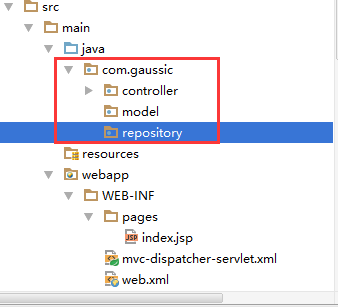



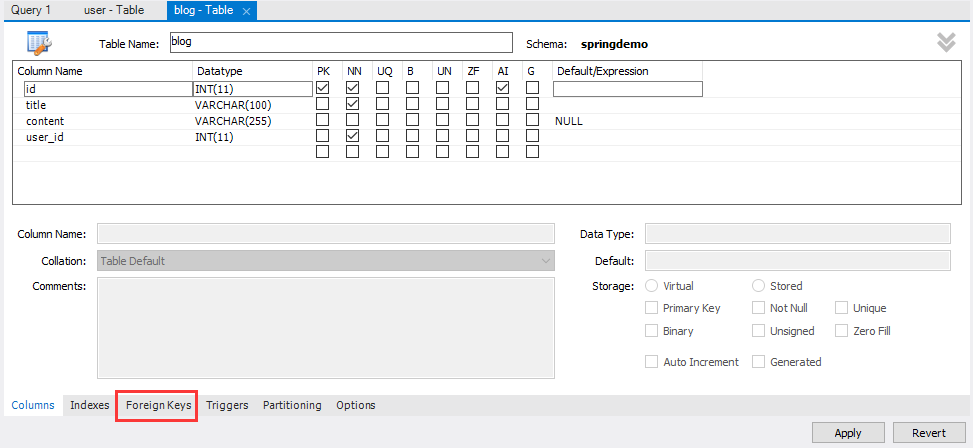
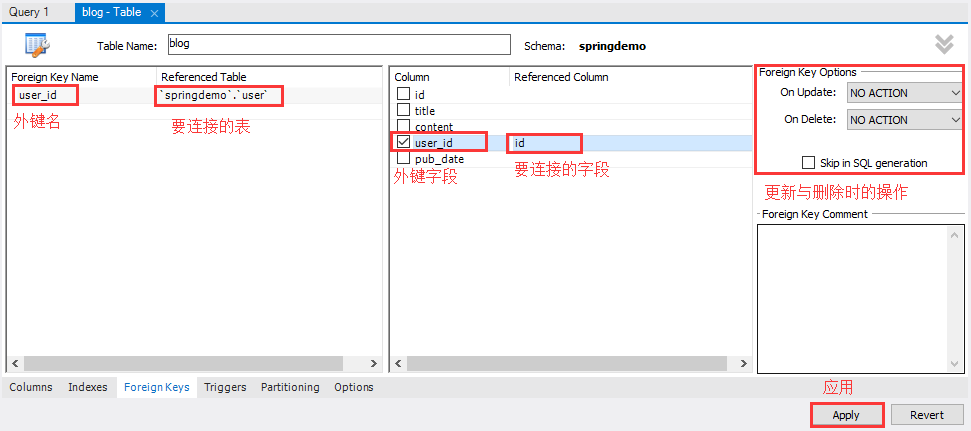
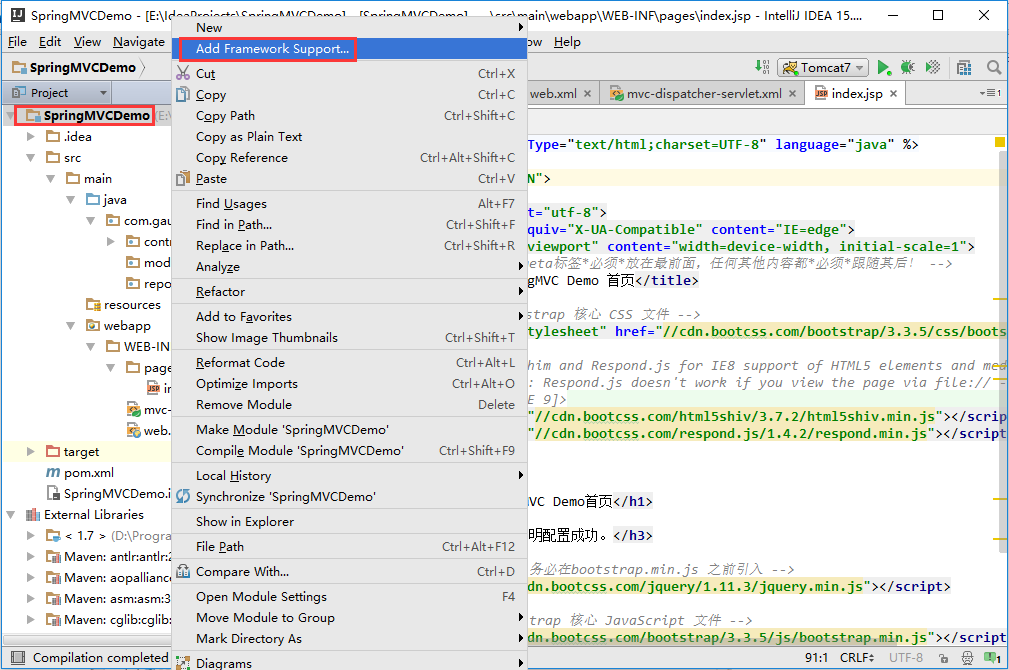

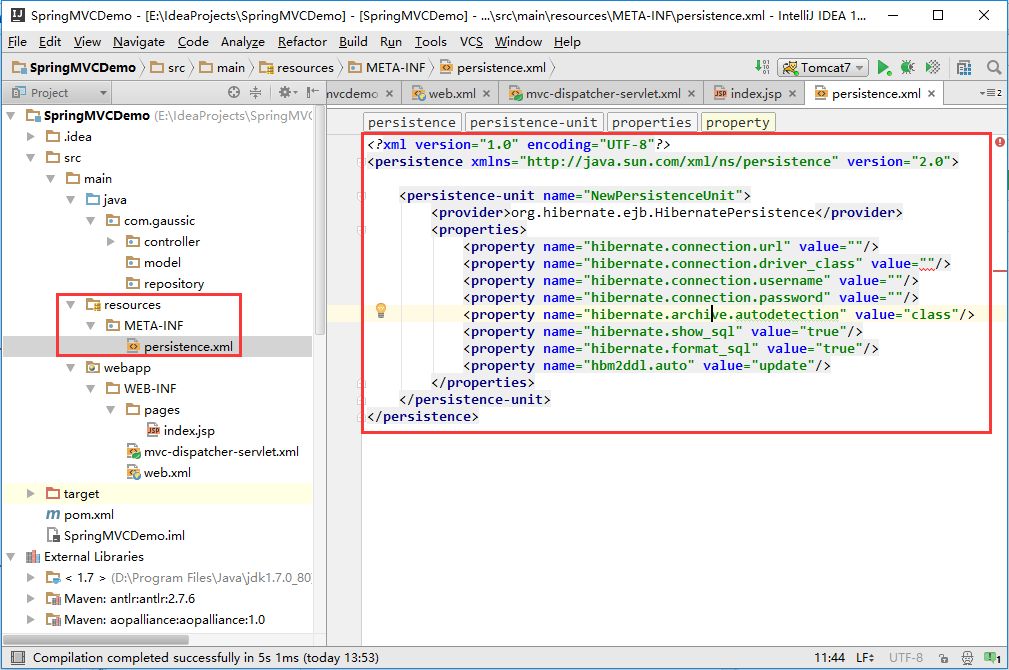
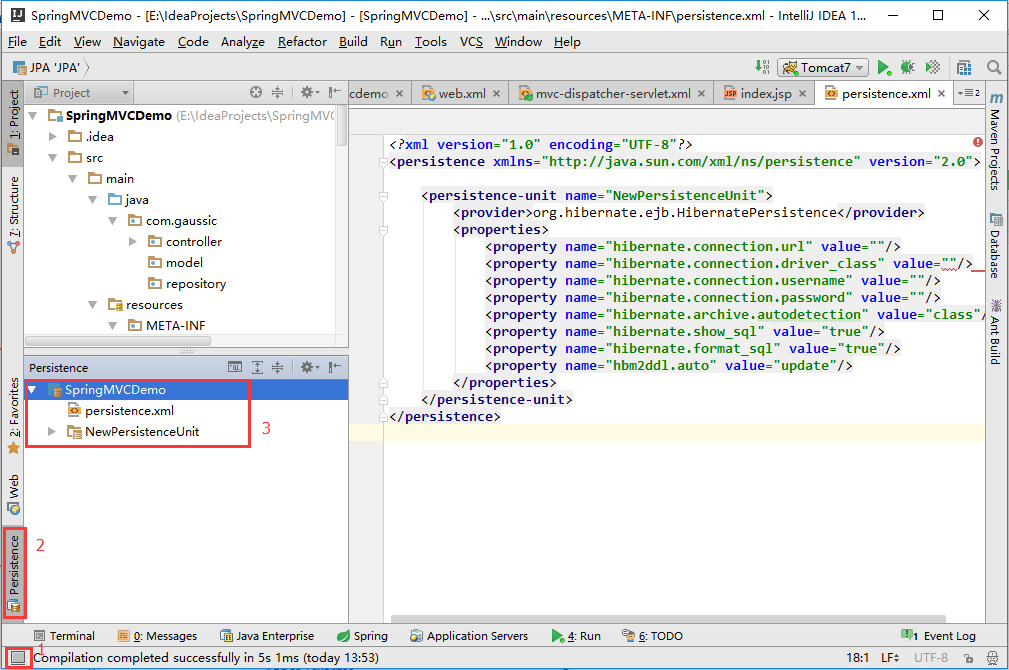

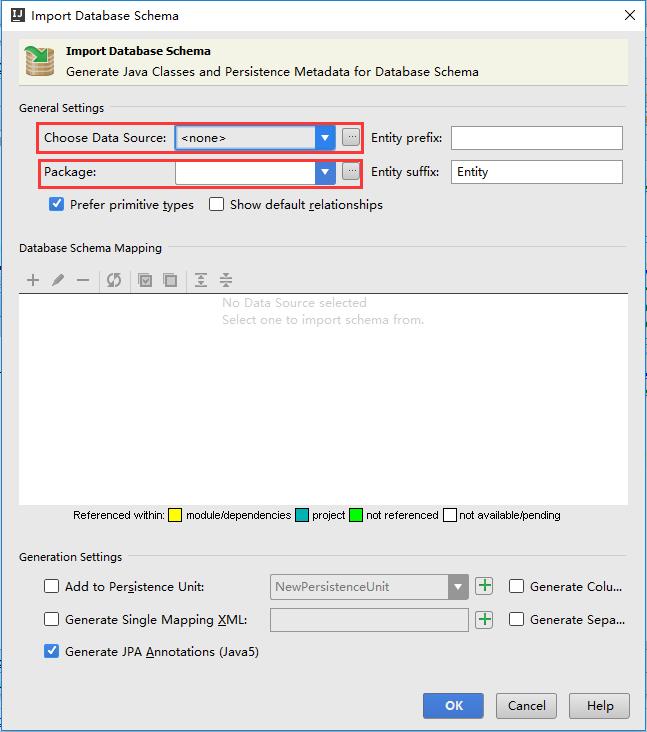
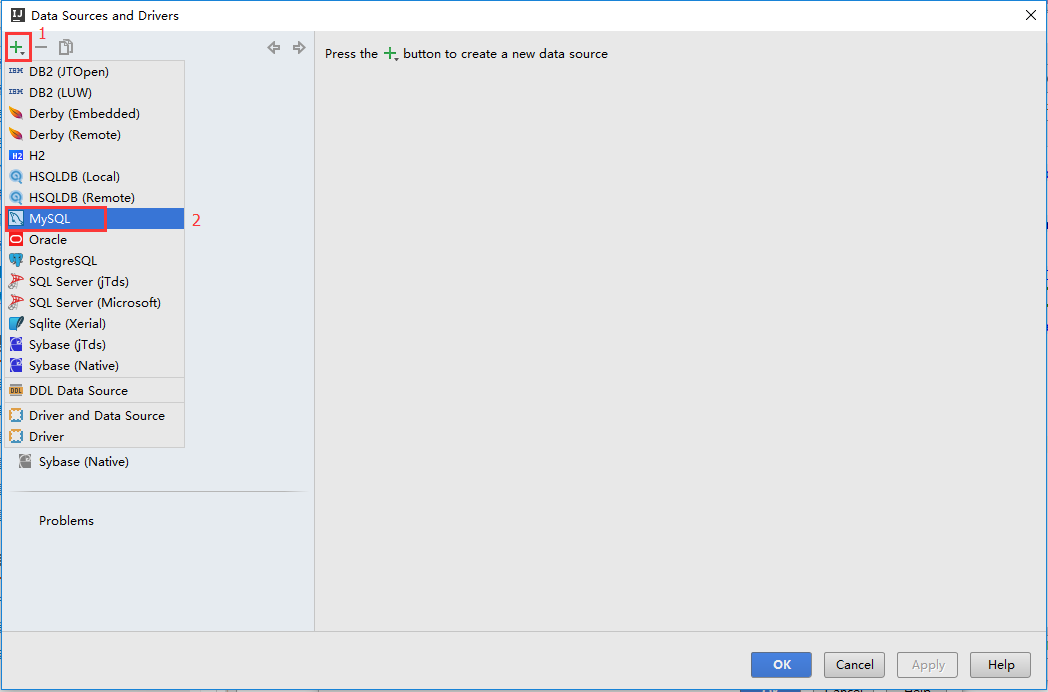

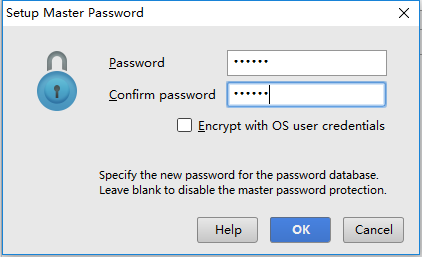
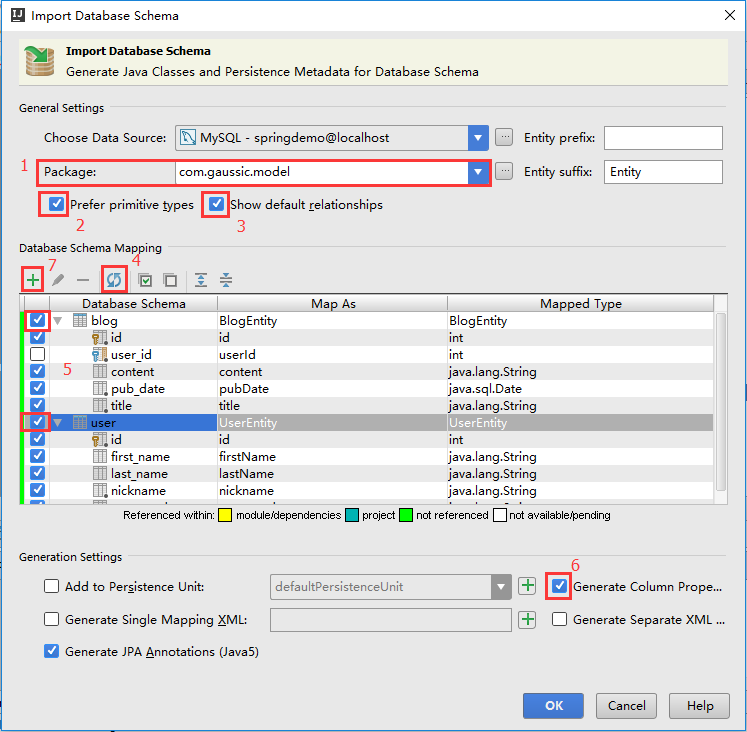

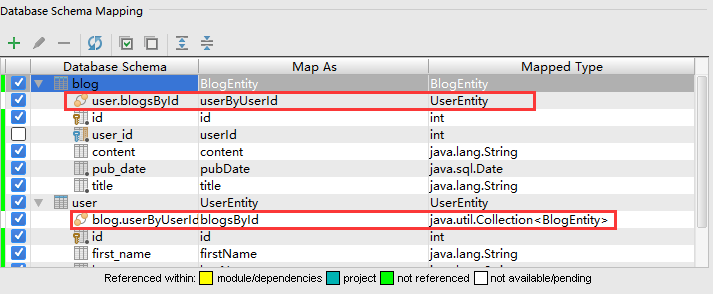
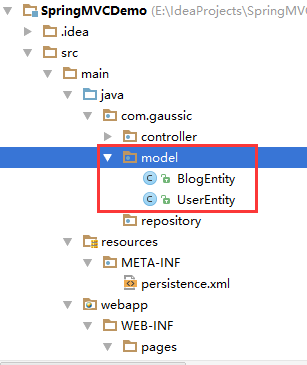













 815
815











 被折叠的 条评论
为什么被折叠?
被折叠的 条评论
为什么被折叠?








